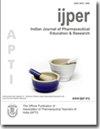Implementation of Analytical Quality by Design Methodology to Develop a UV Spectrometric Technique for Arteether Quantification
IF 0.8
4区 医学
Q3 EDUCATION, SCIENTIFIC DISCIPLINES
Indian Journal of Pharmaceutical Education and Research
Pub Date : 2023-08-23
DOI:10.5530/ijper.57.3s.91
引用次数: 0
Abstract
Aim/Background: Analytical Quality by Design refers to applying the Quality by Design idea to the development of analytical procedures. The present study emphasizes the AQbD concept of developing and validating a spectrophotometric technique for detecting α, β-arteether per the ICH Q8 ( R 2 ) requirements for the first time. Materials and Methods: Sample preparation, sample pH, and wavelength were all integrated into the Ishikawa diagram, and essential parameters were obtained. The ratio of ethanolic PBS 6.8 and HCl was taken as factors. At the same time, the drug molecule's absorbance was identified as a critical factor that was further analyzed using a simple mixture design of experiments methodology for method robustness and optimization. The novel, durable, precise, and accurate UV-spectrophotometric method, α, β-arteether, was developed using the Quality by Design principle. By adjusting the HCl concentration (for acid degradation) and ethanolic PBS 6.8, the highest absorption of α, β-arteether was achieved by heating at 50°C for 30 min. Results and Discussion: The percent RSD less than 2, R 2 > 0.99 was recorded for the concentration range of 2–20 μg/mL at λ max 254 nm. The developed method's LOD and LOQ were within acceptable limits. The presented approach might be used at the industrial level as a rapid, precise, accurate, and cost-effective quality control method for a frequent and simultaneous estimate of α, β-arteether.用设计方法实现分析质量——建立一种紫外光光谱法测定乙醚含量的方法
目的/背景:设计分析质量是指将设计质量理念应用于分析程序的开发。本研究强调了AQbD的概念,即首次根据ICH Q8(R2)要求开发和验证检测α,β-arteether的分光光度法技术。材料和方法:将样品制备、样品pH值和波长都整合到石川图中,并获得基本参数。将乙醇PBS 6.8和HCl的比例作为因素。同时,药物分子的吸光度被确定为一个关键因素,并使用简单的混合设计实验方法进行进一步分析,以提高方法的稳健性和优化性。采用设计质量原则,建立了一种新颖、持久、准确的紫外分光光度法,即α,β-arteether。通过调节HCl浓度(用于酸降解)和乙醇PBS 6.8,在50°C下加热30分钟可获得对α,β-arteether的最高吸收。结果与讨论:在λmax 254 nm的2–20μg/mL浓度范围内,记录的RSD百分比小于2,R2>0.99。所开发的方法的LOD和LOQ在可接受的限度内。所提出的方法可以在工业水平上用作一种快速、精确、准确和成本效益高的质量控制方法,用于频繁和同时估计α,β-arteether。
本文章由计算机程序翻译,如有差异,请以英文原文为准。
求助全文
约1分钟内获得全文
求助全文
来源期刊
CiteScore
1.40
自引率
0.00%
发文量
227
审稿时长
>12 weeks
期刊介绍:
The official journal of Association of Pharmaceutical Teachers of India (APTI) and is being published since 1967. IJPER, a quarterly publication devoted to publish reviews and research articles in pharmacy and the related disciplines of Pharmaceutical education. It mainly covers the articles of special interest, covering the areas of Pharmaceutical research, teaching and learning, laboratory innovations, education technology, curriculum design, examination reforms, training and other related issues. It encourages debates and discussions on the issues of vital importance to Pharmaceutical education and research. The goal of the journal is to provide the quality publications and publish most important research and review articles in the field of drug development and pharmaceutical education. It is circulated and referred by more than 6000 teachers, 40,000 students and over 1000 professionals working in Pharmaceutical industries, Regulatory departments, hospitals etc.

 求助内容:
求助内容: 应助结果提醒方式:
应助结果提醒方式:


